Optimizing Lifespan of Circular Products: A Generic Dynamic Programming Approach for Energy-Using Products
Abstract
:1. Introduction
Optimal Environmental Lifespan
2. Generic Lifespan Optimization of Circular Products
2.1. Developing Decision Tree with a Varying Number of Replacement Options
2.1.1. Modeling Impacts in the Decision Tree
2.1.2. Technology-Specific Functions
2.2. Finding Optimal Path in the Decision Tree Determining Optimal Lifespan
2.2.1. Optimization of Cumulative Impacts with Dynamic Programming
2.2.2. Optimal Path
2.2.3. Optimal Lifespan
3. Application to Case Study
3.1. Model Structure and Technology Assumptions for Gas Boilers
3.1.1. Continuous Technology Improvement of Gas Boiler Technology
3.1.2. Re-Manufacturing
3.1.3. Efficiency Degradation
3.1.4. Heat Demand
3.2. Further Assumptions for LCA and LCC
3.3. Extended Scenario Analysis
4. Results
Extended Scenario Analysis
5. Discussion
5.1. Methodological Aspects
5.2. Case Study Implications
6. Conclusions
Supplementary Materials
Author Contributions
Funding
Data Availability Statement
Acknowledgments
Conflicts of Interest
Abbreviations
| CE | Circular Economy |
| EoL | End of Life |
| EuP | Energy-Using Products |
| OEL | Optimal Environmental Lifespan |
| WEEE | Waste of Electrical and Electronic Equipment |
References
- Bocken, N.M.P.; Olivetti, E.A.; Cullen, J.M.; Potting, J.; Lifset, R. Taking the Circularity to the Next Level: A Special Issue on the Circular Economy. J. Ind. Ecol. 2017, 21, 476–482. [Google Scholar] [CrossRef]
- A New Circular Economy Action Plan: For a Cleaner and More Competitive Europe; European Commission: Brussels, Belgium, 2020.
- den Hollander, M.C.; Bakker, C.A.; Hultink, E.J. Product Design in a Circular Economy: Development of a Typology of Key Concepts and Terms. J. Ind. Ecol. 2017, 21, 517–525. [Google Scholar] [CrossRef]
- Desing, H.; Brunner, D.; Takacs, F.; Nahrath, S.; Frankenberger, K.; Hischier, R. A circular economy within the planetary boundaries: Towards a resource-based, systemic approach. Resour. Conserv. Recycl. 2020, 155, 104673. [Google Scholar] [CrossRef]
- Potting, J.; Hekkert, M.; Worrell, E.; Hanemaaijer, A. Circular Economy: Measuring Innovation in the Product Chain: Policy Report; Planbureau voor de Leefomgeving: The Hague, The Netherlands, 2017. [Google Scholar]
- Sonderegger, T.; Dewulf, J.; Fantke, P.; Souza, D.M.; Pfister, S.; Stoessel, F.; Verones, F.; Vieira, M.; Weidema, B.; Hellweg, S. Towards harmonizing natural resources as an area of protection in life cycle impact assessment. Int. J. Life Cycle Assess. 2017, 22, 1912–1927. [Google Scholar] [CrossRef]
- European Union. EU Waste Framework Directive: 2008/98/EC. Off. J. Eur. Union 2008, L 312, 3–30. [Google Scholar]
- Reuter, M.A.; van Schaik, A.; Gutzmer, J.; Bartie, N.; Abadías-Llamas, A. Challenges of the Circular Economy: A Material, Metallurgical, and Product Design Perspective. Annu. Rev. Mater. Res. 2019, 49, 253–274. [Google Scholar] [CrossRef]
- Castro, M.; Remmerswaal, J.; Reuter, M.A.; Boin, U. A thermodynamic approach to the compatibility of materials combinations for recycling. Resour. Conserv. Recycl. 2004, 43, 1–19. [Google Scholar] [CrossRef]
- Løvik, A.N.; Müller, D.B. A Material Flow Model for Impurity Accumulation in Beverage Can Recycling Systems. In Light Metals; Springer: Cham, Switzerland, 2014; pp. 907–911. [Google Scholar]
- Rechberger, H.; Graedel, T.E. The contemporary European copper cycle: Statistical entropy analysis. Ecol. Econ. 2002, 42, 59–72. [Google Scholar] [CrossRef]
- Allwood, J.M.; Ashby, M.F.; Gutowski, T.G.; Worrell, E. Material efficiency: A white paper. Resour. Conserv. Recycl. 2011, 55, 362–381. [Google Scholar] [CrossRef]
- Cooper, T. Slower Consumption Reflections on Product Life Spans and the “Throwaway Society”. J. Ind. Ecol. 2005, 9, 51–67. [Google Scholar] [CrossRef]
- van Nes, N.; Cramer, J. Product lifetime optimization: A challenging strategy towards more sustainable consumption patterns. J. Clean. Prod. 2006, 14, 1307–1318. [Google Scholar] [CrossRef]
- Cooper, D.R.; Gutowski, T.G. The Environmental Impacts of Reuse: A Review. J. Ind. Ecol. 2017, 21, 38–56. [Google Scholar] [CrossRef]
- Iraldo, F.; Facheris, C.; Nucci, B. Is product durability better for environment and for economic efficiency? A comparative assessment applying LCA and LCC to two energy-intensive products. J. Clean. Prod. 2017, 140, 1353–1364. [Google Scholar] [CrossRef]
- Ardente, F.; Talens Peiró, L.; Mathieux, F.; Polverini, D. Accounting for the environmental benefits of remanufactured products: Method and application. J. Clean. Prod. 2018, 198, 1545–1558. [Google Scholar] [CrossRef] [PubMed]
- Dewulf, W.; Duflou, J.R. The environmentally optimised lifetime: A crucial concept in life cycle engineering. In Proceedings of the Global Conference on Sustainable Product Development and Life Cycle Engineering, Berlin, Germany, 29 September–1 October 2004; pp. 59–62. [Google Scholar]
- Truttmann, N.; Rechberger, H. Contribution to resource conservation by reuse of electrical and electronic household appliances. Resour. Conserv. Recycl. 2006, 48, 249–262. [Google Scholar] [CrossRef]
- Bodlak, L. Ökologisch Optimale Lebensdauer von Weißware: Recherche zu Lebenszyklus-Studien (LCA) Ausgewählter Produktgruppen (Weißware); Energieinstitut Vorarlberg: Dornbirn, Austria, 2018. [Google Scholar]
- Guidance to Improve Product Durability; Wrap: Banbury, UK, 2019.
- Ardente, F.; Mathieux, F. Identification and assessment of product’s measures to improve resource efficiency: The case-study of an Energy using Product. J. Clean. Prod. 2014, 83, 126–141. [Google Scholar] [CrossRef]
- Gensch, C.O.; Blepp, M. Lebensdauer und Ersatzstrategien von Miele-Haushaltsgeräten; Öko-Institut e.V.: Freiburg, Germany, 2015. [Google Scholar]
- Boldoczki, S.; Thorenz, A.; Tuma, A. The environmental impacts of preparation for reuse: A case study of WEEE reuse in Germany. J. Clean. Prod. 2020, 252, 119736. [Google Scholar] [CrossRef]
- Bakker, C.; den Hollander, M.; van Hinte, E.; Zijlstra. Products That Last: Product Design for Circular Business Models; TU Delft Library: Delft, The Netherlands, 2014. [Google Scholar]
- Hischier, R.; Böni, H.W. Combining environmental and economic factors to evaluate the reuse of electrical and electronic equipment—A Swiss case study. Resour. Conserv. Recycl. 2021, 166, 105307. [Google Scholar] [CrossRef]
- Schaubroeck, S.; Schaubroeck, T.; Baustert, P.; Gibon, T.; Benetto, E. When to replace a product to decrease environmental impact? A consequential LCA framework and case study on car replacement. Int. J. Life Cycle Assess. 2020, 25, 1500–1521. [Google Scholar] [CrossRef]
- Jensen, P.B.; Laursen, L.N.; Haase, L.M. Barriers to product longevity: A review of business, product development and user perspectives. J. Clean. Prod. 2021, 313, 127951. [Google Scholar] [CrossRef]
- van Loon, P.; Diener, D.; Harris, S. Circular products and business models and environmental impact reductions: Current knowledge and knowledge gaps. J. Clean. Prod. 2021, 288, 125627. [Google Scholar] [CrossRef]
- Skelton, A.C.H.; Allwood, J.M. Product life trade-offs: What if products fail early? Environ. Sci. Technol. 2013, 47, 1719–1728. [Google Scholar] [CrossRef]
- Kim, H.C.; Keoleian, G.A.; Grande, D.E.; Bean, J.C. SI: Life cycle optimization of automobile replacement: Model and application: Dynamic Life Cycle Inventories for Mid-Sized Cars. Environ. Sci. Technol. 2003, 37, 5407–5413. [Google Scholar] [CrossRef] [PubMed]
- Kim, H.C.; Keoleian, G.A.; Horie, Y.A. Optimal household refrigerator replacement policy for life cycle energy, greenhouse gas emissions, and cost. Energy Policy 2006, 34, 2310–2323. [Google Scholar] [CrossRef]
- de Kleine, R.D.; Keoleian, G.A.; Kelly, J.C. Optimal replacement of residential air conditioning equipment to minimize energy, greenhouse gas emissions, and consumer cost in the US. Energy Policy 2011, 39, 3144–3153. [Google Scholar] [CrossRef]
- Bakker, C.; Wang, F.; Huisman, J.; den Hollander, M. Products that go round: Exploring product life extension through design. J. Clean. Prod. 2014, 69, 10–16. [Google Scholar] [CrossRef]
- Liu, L.; Keoleian, G.A.; Saitou, K. Replacement policy of residential lighting optimized for cost, energy, and greenhouse gas emissions. Environ. Res. Lett. 2017, 12, 114034. [Google Scholar] [CrossRef]
- Pérez-Belis, V.; Bakker, C.; Juan, P.; Bovea, M.D. Environmental performance of alternative end-of-life scenarios for electrical and electronic equipment: A case study for vacuum cleaners. J. Clean. Prod. 2017, 159, 158–170. [Google Scholar] [CrossRef]
- Chung, W.H.; Kremer, G.E.O.; Wysk, R.A. A dynamic programming method for product upgrade planning incorporating technology development and end-of-life decisions. J. Ind. Prod. Eng. 2017, 34, 30–41. [Google Scholar] [CrossRef]
- European Union. Commission Regulation (EU) No 622/2012 of 11 July 2012 amending Regulation (EC) No 641/2009 with regard to ecodesign requirements for glandless standalone circulators and glandless circulators integrated in productsText with EEA relevance. Off. J. Eur. Union 2012, L 180, 4–8. [Google Scholar]
- Bellman, R.E. Dynamic Programming; Princeton University Press: Princeton, NJ, USA, 1957. [Google Scholar]
- Hellweg, S.; Hofstetter, T.B.; Hungerbühler, K. Discounting and the Environment: Should Current Impacts be Weighted Differently than Impacts Harming Future Generations? Int. J. Life Cycle Assess. 2003, 8, 8–18. [Google Scholar] [CrossRef]
- EU Pathways to a Decarbonised Building Sector: How Replacing Inefficient Heating Systems Can Help Reach the EU Climate Ambitions; ECOFYS: Utrecht, The Netherlands, 2016.
- Effizienzklassen-Rechner; Bundesministerium für Wirtschaft und Klimaschutz (BMWI): Berlin, Germany, 2018.
- Der dena-Gebäudereport 2016: Statistiken und Analysen zur Energieeffizienz im Gebäudebestand; Deutsche Energie-Agentur (dena): Berlin, Germany, 2016.
- BRG. The European Heating Product Markets: Germany. 2018. Available online: https://www.brgbuildingsolutions.com (accessed on 21 January 2021).
- Energieverbrauch Privater Haushalte für Wohnen 2017 Erneut Gestiegen; DESTATIS: Wiesbaden, Germany, 2018.
- Oschatz, B.; Mailach, B. CO2-Einsparungen durch Heizungsmodernisierungen; BDH (Bundesverband der Deutschen Heizungsindustrie e.V.): Cologne, Germany, 2015. [Google Scholar]
- Hellweg, S.; Mila i Canals, L. Emerging approaches, challenges and opportunities in life cycle assessment. Science 2014, 344, 1109–1113. [Google Scholar] [CrossRef] [PubMed]
- Steffen, W.; Richardson, K.; Rockström, J.; Cornell, S.E.; Fetzer, I.; Bennett, E.M.; Biggs, R.; Carpenter, S.R.; de Vries, W.; de Wit, C.A.; et al. Sustainability. Planetary boundaries: Guiding human development on a changing planet. Science 2015, 347, 1259855. [Google Scholar] [CrossRef]
- The Global Risks Report 2020; World Economic Forum: Cologny, Switzerland, 2020.
- IPCC. Climate Change 2013: The Physical Science Basis. Working Group I Contribution to the Fifth Assessment Report of the Intergovernmental Panel on Climate Change; IPCC: Geneva, Switzerland, 2013. [Google Scholar]
- Goedkoop, M.; Heijungs, R.; Huijbregts, M.; de Schryver, A.; Struijs, J.; van Zelm, R. ReCiPe 2008: A Life Cycle Impact Assessment Method Which Comprises Harmonised Category Indicators at the Midpoint and the Endpoint Level. Report I: Characterisation; Ministerie van Volkshuisvesting Ruimtelijke Ordening en Milieubeheer: The Hauge, The Netherlands, 2013. [Google Scholar]
- Reich, M.C. Economic assessment of municipal waste management systems—Case studies using a combination of life cycle assessment (LCA) and life cycle costing (LCC). J. Clean. Prod. 2005, 13, 253–263. [Google Scholar] [CrossRef]
- Mutel, C. Brightway: An open source framework for Life Cycle Assessment. J. Open Source Softw. 2017, 2, 236. [Google Scholar] [CrossRef]
- Wernet, G.; Bauer, C.; Steubing, B.; Reinhard, J.; Moreno-Ruiz, E.; Weidema, B. The ecoinvent database version 3 (part I): Overview and methodology. Int. J. Life Cycle Assess. 2016, 21, 1218–1230. [Google Scholar] [CrossRef]
- Kemna, R.; Elburg, M.v.; Li, W.; Holsteijn, R.v. Preparation Study on Eco-design of Boilers: Task 3 Report: Consumer Behaviour & Local Infrastructure; European Commission: Brussels, Belgium, 2007. [Google Scholar]
- Toxopeus, M.E.; Haanstra, W.; van Gerrevink, M.R.; van der Meide, R. A Case Study on Industrial Collaboration to Close Material Loops for a Domestic Boiler. Procedia CIRP 2017, 61, 52–57. [Google Scholar] [CrossRef]
- Verordnung über Energiesparenden Wärmeschutz und Energiesparende Anlagentechnik bei Gebäuden (Energieeinsparverordnung—EnEV); Bundesanzeiger: Berlin, Germany, 2007.
- Energieeffizienz von Heizgeräten; BMWI: Berlin, Germany, 2018.
- DIN 15316-4-1:2017; Energetische Bewertung von Gebäuden—Verfahren zur Berechnung der Energieanforderungen und Nutzungsgrade der Anlagen: Wärmeerzeugung für die Raumheizung und Trinkwassererwärmung, Verbrennungssysteme (Heizungskessel, Biomasse), Modul M3-8-1, M8-8-1. Deutsches Institut für Normung: Berlin, Germany, 2017.
- Enterprise Resource Planning (ERP) Database at Bosch Thermotechnology GmbH; Bosch: Wetzlar, Germany, 2019.
- Kemna, R.; Elburg, M.v. Ecodesign Review Study: Task 2: Market Analysis. 2019. Available online: https://www.ecoboiler-review.eu/Boilers2017-2019/downloads/Boilers%20Task%202%20final%20report%20July%202019.pdf (accessed on 29 May 2023).
- BSI 8887-2:2009; Design for Manufacture, Assembly, Disassembly and End-of-life Processing (MADE). Terms and Definitions. British Standards Institution: London, UK, 2009.
- Nasr, N.; Russell, J.; Bringezu, S.; Hellweg, S.; Hilton, B.; Kreiss, C.; von Gries, N. Re-defining Value: The Manufacturing Revolution: Remanufacturing, Refurbishment, Repair and Direct Reuse in the Circular Economy: A Report of the International Resource Panel; International Resource Panel: Paris, France, 2018. [Google Scholar]
- Hummen, T.; Wege, E. Remanufacturing of Energy using Products makes sense only when technology is mature: Introducing a Circular Economy indicator for remanufacturing based on a parameterized LCA and LCC assessment of a circulation pump. In Progress in Life Cycle Assessment 2019; Albrecht, S., Fischer, M., Leistner, P., Schebek, L., Eds.; Springer: Cham, Switzerland, 2020; pp. 67–82. [Google Scholar]
- Baxter, J. Systematic environmental assessment of end-of-life pathways for domestic refrigerators. J. Clean. Prod. 2019, 208, 612–620. [Google Scholar] [CrossRef]
- Baldi, S.; Le Quang, T.; Holub, O.; Endel, P. Real-time monitoring energy efficiency and performance degradation of condensing boilers. Energy Convers. Manag. 2017, 136, 329–339. [Google Scholar] [CrossRef]
- Eleftheriadis, G.; Hamdy, M. The Impact of Insulation and HVAC Degradation on Overall Building Energy Performance: A Case Study. Buildings 2018, 8, 23. [Google Scholar] [CrossRef]
- Hendron, R. Building America Performance Analysis Procedures for Existing Homes; National Renewable Energy Laboratory: Golden, CO, USA, 2006. [Google Scholar] [CrossRef]
- Enerdata. Entranze Forecasts Database. 2014. Available online: https://entranze-scenario.enerdata.net/site/ (accessed on 14 August 2017).
- Diefenbach, N. Deutscher Gebäudebestand: Basisdaten und Modellrechnungen bis 2020; Institut Wohnen und Umwelt GmbH: Darmstadt, Germany, 2010. [Google Scholar]
- Caduff, M.; Huijbregts, M.A.; Koehler, A.; Althaus, H.J.; Hellweg, S. Scaling Relationships in Life Cycle Assessment. J. Ind. Ecol. 2014, 18, 393–406. [Google Scholar] [CrossRef]
- Vignali, G. Environmental assessment of domestic boilers: A comparison of condensing and traditional technology using life cycle assessment methodology. J. Clean. Prod. 2017, 142, 2493–2508. [Google Scholar] [CrossRef]
- BDEW. Wie Heizt Deutschland 2019? BDEW: Berlin, Germany, 2019. [Google Scholar]
- BMU. Klimaschutzplan 2050: Klimaschutzpolitische Grundsätze und Ziele der Bundesregierung; BMU: Berlin, Germany, 2016. [Google Scholar]
- BMWI. Nationales Reformprogramm 2020—Die Nationale Wasserstoffstrategie; BMWI: Berlin, Germany, 2020. [Google Scholar]
- Marcogaz. Overview of Available Test Results and Regulatory Limits Forhydrogen Admission into Existing Natural Gas Infrastructure and End Use; Marcogaz: Brussels, Belgium, 2019. [Google Scholar]
- BMUB. Entwurf eines Ersten Gesetzes zur Änderung des Brennstoffemissionshandelsgesetzes; BMUB: Berlin, Germany, 2020. [Google Scholar]
- Bünger, B.; Matthey, A. Methodenkonvention 3.0 zur Ermittlung von Umweltkosten: Methodische Grundlagen; Umwelt Bundesamt: Dessau-Roßlau, Germany, 2018. [Google Scholar]
- Hauschild, M.Z.; Rosenbaum, R.K.; Olsen, S.I. (Eds.) Life Cycle Assessment: Theory and Practice; Springer: Cham, Switzerland, 2017. [Google Scholar]
- Thamling, N.; Pehnt, M.; Kirchner, J. Hintergrundpapier zur Energieeffizienzstrategie Gebäude: Erstellt im Rahmen der Wissenschaftlichen Begleitforschung zur ESG; Prognos: Basel, Switzerland, 2015. [Google Scholar]
- Kemna, R.; Elburg, M.V.; van den Boorn, R.; Aarts, S. Ecodesign Review Study: Task 5: Environment and Economics; European Commission: Brussels, Belgium, 2019. [Google Scholar]
- Bobba, S.; Ardente, F.; Mathieux, F. Environmental and economic assessment of durability of energy-using products: Method and application to a case-study vacuum cleaner. J. Clean. Prod. 2016, 137, 762–776. [Google Scholar] [CrossRef]
- BDH. Heizungsmarkt Deutschland; BDH: Köln, Germany, 2012. [Google Scholar]
- BDH. Marktentwicklung Wärmeerzeuger 2005–2015; BDH: Köln, Germany, 2015. [Google Scholar]
- BDH. Wärmewende: Keine Energiewende ohne den Wärmemarkt; BDH: Köln, Germany, 2019. [Google Scholar]
- Destatis. Statistik der Baufertigstellungen; DESTATIS: Wiesbaden, Germany, 2019. [Google Scholar]
- Jacob, P. Projected Obsolescence in Electric and Electronic Consumer Equipment? What are the Limiters of Lifetime, Service Life and Repairability of Modern Consumer Electr(on)ics? In Proceedings of the Electronics Goes Green 2020+, Online, 1 September 2020.
- European Union. Directive 2009/125/EG of the European Parliament and of the Council of 21 October 2009: Establishing a framework for the setting of ecodesign requirements for energy-related products. Off. J. Eur. Union 2009, L 285, 10–35. [Google Scholar]
- Spreafico, C.; Landi, D.; Russo, D. A new method of patent analysis to support prospective life cycle assessment of eco-design solutions. Sustain. Prod. Consum. 2023, 38, 241–251. [Google Scholar] [CrossRef]
- Wesche, J.P.; Negro, S.O.; Dütschke, E.; Raven, R.; Hekkert, M.P. Configurational innovation systems—Explaining the slow German heat transition. Energy Res. Soc. Sci. 2019, 52, 99–113. [Google Scholar] [CrossRef]
- Bafa. Förderübersicht: Heizen mit Erneuerbaren Energien 2020; BAFA: Eschborn, Germany, 2020. [Google Scholar]
- Bafa. Förderübersicht: Bundesförderung für Effiziente Gebäude (BEG); BAFA: Eschborn, Germany, 2021. [Google Scholar]
- Schmidt, D.; Shukuya, M. New ways towards increased efficiency in the utilization of energy flows in buildings. In Proceedings of the Second International Building Physics Conference, Leuven, Belgium, 14–18 September 2003; pp. 671–681. [Google Scholar]
- Gutowski, T.G.; Sahni, S.; Boustani, A.; Graves, S.C. Remanufacturing and energy savings. Environ. Sci. Technol. 2011, 45, 4540–4547. [Google Scholar] [CrossRef]
- Tolga Balta, M.; Kalinci, Y.; Hepbasli, A. Evaluating a low exergy heating system from the power plant through the heat pump to the building envelope. Energy Build. 2008, 40, 1799–1804. [Google Scholar] [CrossRef]
- Abusoglu, A.; Sedeeq, M.S. Comparative exergoenvironmental analysis and assessment of various residential heating systems. Energy Build. 2013, 62, 268–277. [Google Scholar] [CrossRef]
- Becker-Hardt, D. Development and Evaluation of Circular Business Models in the Market of Residential Heating: Analysis of Needed Design Implications. Master’s Thesis, University of Kassel, Kassel, Germany, 2018. [Google Scholar]
- Towards the Circular Economy; Ellen Mc Arthur Foundation: Isle of Wight, UK, 2015.
- Franklin-Johnson, E.; Figge, F.; Canning, L. Resource duration as a managerial indicator for Circular Economy performance. J. Clean. Prod. 2016, 133, 589–598. [Google Scholar] [CrossRef]
- Elia, V.; Gnoni, M.G.; Tornese, F. Measuring circular economy strategies through index methods: A critical analysis. J. Clean. Prod. 2017, 142, 2741–2751. [Google Scholar] [CrossRef]
- Parchomenko, A.; Nelen, D.; Gillabel, J.; Rechberger, H. Measuring the circular economy—A Multiple Correspondence Analysis of 63 metrics. J. Clean. Prod. 2019, 210, 200–216. [Google Scholar] [CrossRef]
- Waste Electrical and Electronic Equipment (WEEE) by Waste Management Operations; Eurostat: Luxembourg, 2019.
- prEN 45550:2018; Definitions Related to Material Efficiency. CEN/CLC: Brussels, Belgium, 2018.
- Wang, F.; Huisman, J.; Stevels, A.; Baldé, C.P. Enhancing e-waste estimates: Improving data quality by multivariate Input-Output Analysis. Waste Manag. 2013, 33, 2397–2407. [Google Scholar] [CrossRef] [PubMed]
- Thiébaud-Müller, E.; Hilty, L.M.; Schluep, M.; Widmer, R.; Faulstich, M. Service Lifetime, Storage Time, and Disposal Pathways of Electronic Equipment: A Swiss Case Study. J. Ind. Ecol. 2018, 22, 196–208. [Google Scholar] [CrossRef]
- Erhebungen des Schornsteinfegerhandwerks für 2013; ZIV: Sankt Augustin, Germany, 2013.
- Gas Kann Grün: Die Potentiale von Biogas/Biomethan: Status Quo, Fakten und Entwicklung; BDEW: Berlin, Germany, 2019.
- Adolf, J.; Schabla, U.; Lücke, A.; Breitenbach, L.; Bräuninger, M.; Leschus, L.; Ehrlich, L.; Otto, A.H.; Oschatz, B.; Mailach, B. Shell BDH Hauswärme-Studie: Klimaschutz im Wohnungssektor—Wie Heizen wir morgen? Fakten, Trends und Perspektiven für Heiztechniken bis 2030; Hamburgische WeltWirtschaftsInstitut: Hamburg, Germany, 2013. [Google Scholar]
- Baehr, H.D. Thermodynamik des Heizens und Kühlens. In Thermodynamik; Baehr, H.D., Ed.; Springer: Berlin/Heidelberg, Germany, 2002; pp. 556–593. [Google Scholar]
- European Union. Council Directive 92/42/EEC of 21 May 1992 on efficeincy requirements for new hot-water boilers fired with liquid or gaseous fuels. Off. J. Eur. Union 1992, L 167, 17–28. [Google Scholar]
- Holsteijn, R.v.; Kemna, R.; Elburg, M.v.; Wierda, L. Ecodesign Review Study: Task 7: Scenarios; European Commission: Brussels, Belgium, 2019. [Google Scholar]
- Energieeffizienzstrategie Gebäude: Wege zu einem Nahezu Klimaneutralen Gebäudebestand; BMWI: Berlin, Germany, 2015.
- Diefenbach, N.; Clausnitzer, K.D. Datenbasis Gebäudebestand: Datenerhebung zur Energetischen Qualität und zu den Modernisierungstrends im Deutschen Wohngebäudebestand; Institut Wohnen und Umwelt: Darmstadt, Germany; Bremer Energie-Institut: Bremen, Germany, 2010. [Google Scholar]
- Klimaschutz im Wohngebäudebereich: Wie Können Wir die Klimaschutzziele im Bereich der Wohngebäude in Deutschland bis 2050 Erreichen? nymoen: Berlin, Germany, 2017.
- Entranze: Policies to ENforce the TRAnsition to Nearly Zero Energy Buildings in the EU-27; Enerdata: Grenoble, France, 2014.
- Substitutionsquote: Ein Realistischer Erfolgsmaßstab für die Kreislaufwirtschaft; Umwelt Bundesamt: Dessau-Roßlau, Germany, 2019.
- Entwicklung der Energiemärkte—Energiereferenzprognose; Prognos: Basel, Switzerland, 2014.
- Gasheizung: Kosten und Preise für Ihre Heizung Berechnen; Bosch: Wetzlar, Germany, 2016.
- Verbraucherpreisindex für Deutschland: (Tabellen ab 1948); DESTATIS: Wiesbaden, Germany, 2020.
- Herausforderungen an die Deutsche Wettbewerbsfähigkeit durch einen Neuen Weltenergiemarkt; IHS: Berlin, Germany, 2013.
- Verivox-Verbraucherpreisindex: Gaspreis für Privathaushalte in Deutschland bei einem Gasverbrauch von 20.000 kWh in den Jahren 2005 bis 2020; Verivox: Heidelberg, Germany, 2020.
- Hummen, T. Recycling of Boilers: Material Value of a Gas Boiler and Circulation Pump. Personal communication with Markus Hutzler from Alba. 2019.
- Naturstrom Biogas | 100% Erneuerbare Energien von NATURSTROM; Naturstrom: Düsseldorf, Germany, 2020.
- Anwendungsbilanzen zur Energiebilanz Deutschland: Endenergieverbrauch nach Energieträgern und Anwendungszwecken; AG Energiebilanzen e.V.: Berlin, Germany, 2019.
- Zhang, X.; Bauer, C.; Mutel, C.L.; Volkart, K. Life Cycle Assessment of Power-to-Gas: Approaches, system variations and their environmental implications. Appl. Energy 2017, 190, 326–338. [Google Scholar] [CrossRef]
- Emissionsbilanz Erneuerbarer Energieträger: Bestimmung der Vermiedenen Emissionen im Jahr 2012; Umwelt Bundesamt: Dessau-Roßlau, Germany, 2013.
- Kemna, R.; Elburg, M.v. Ecodesign Review Study: Task 3: Space and Water Heating Demand and Usage. 2019. [Google Scholar]
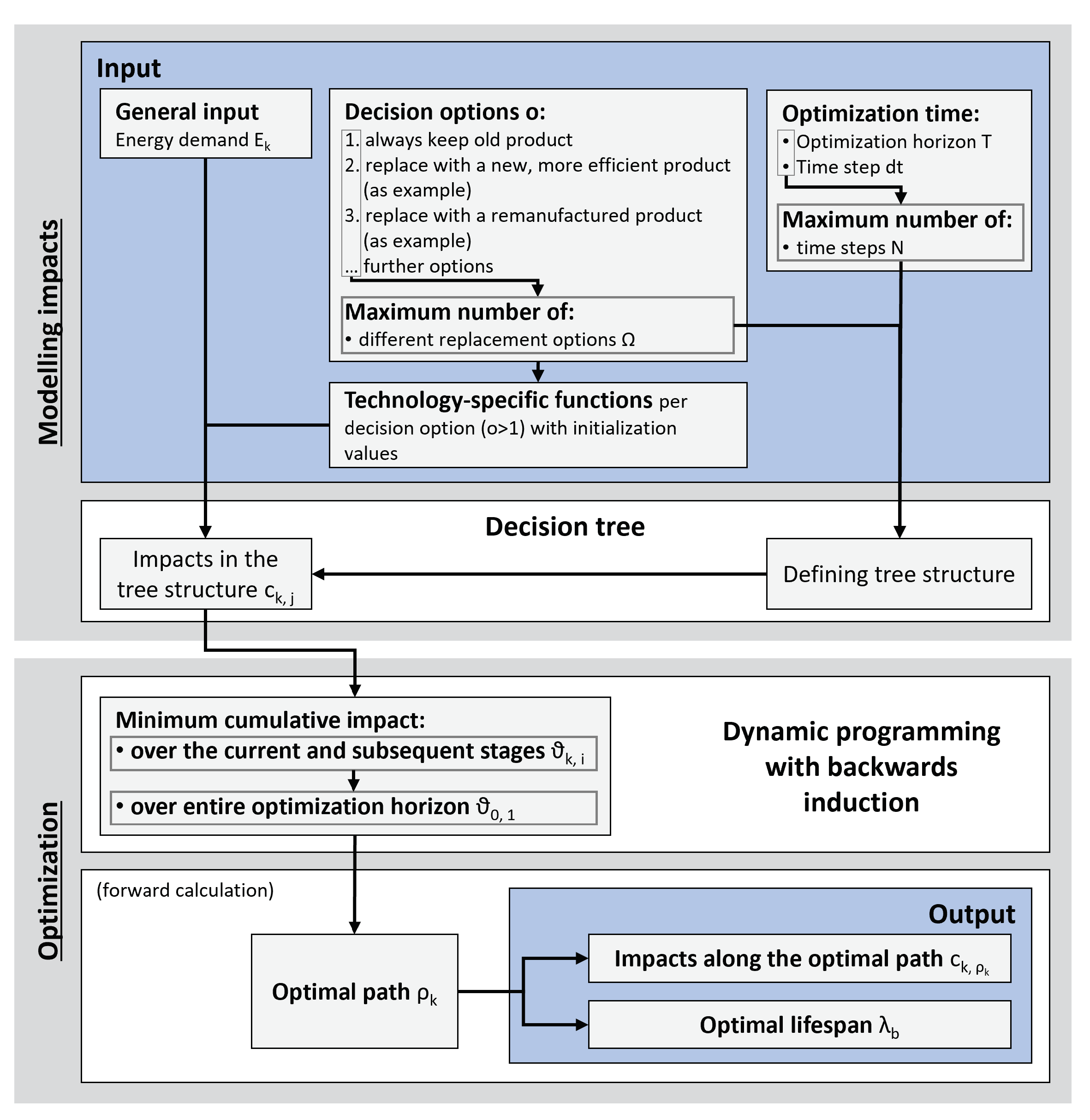

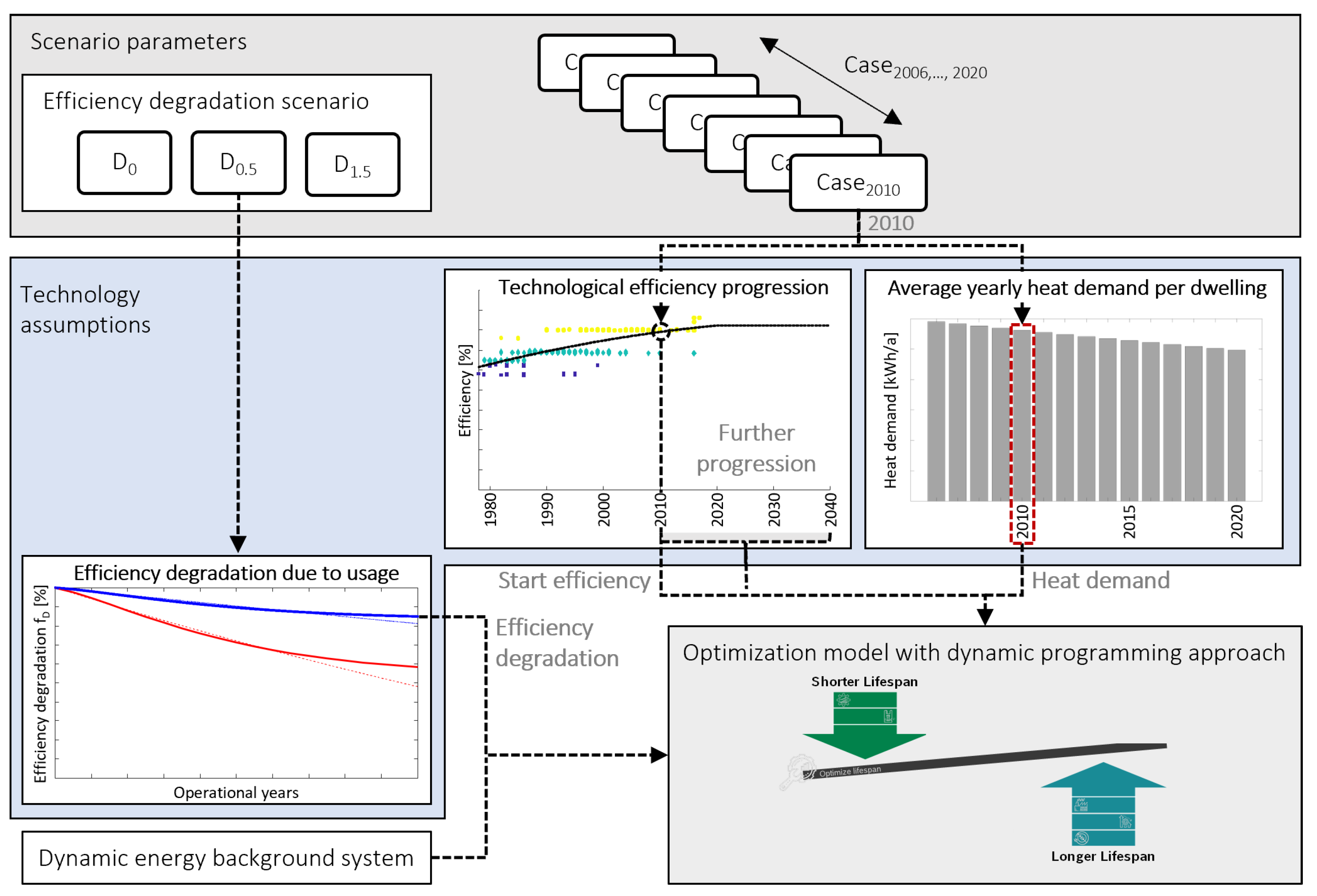
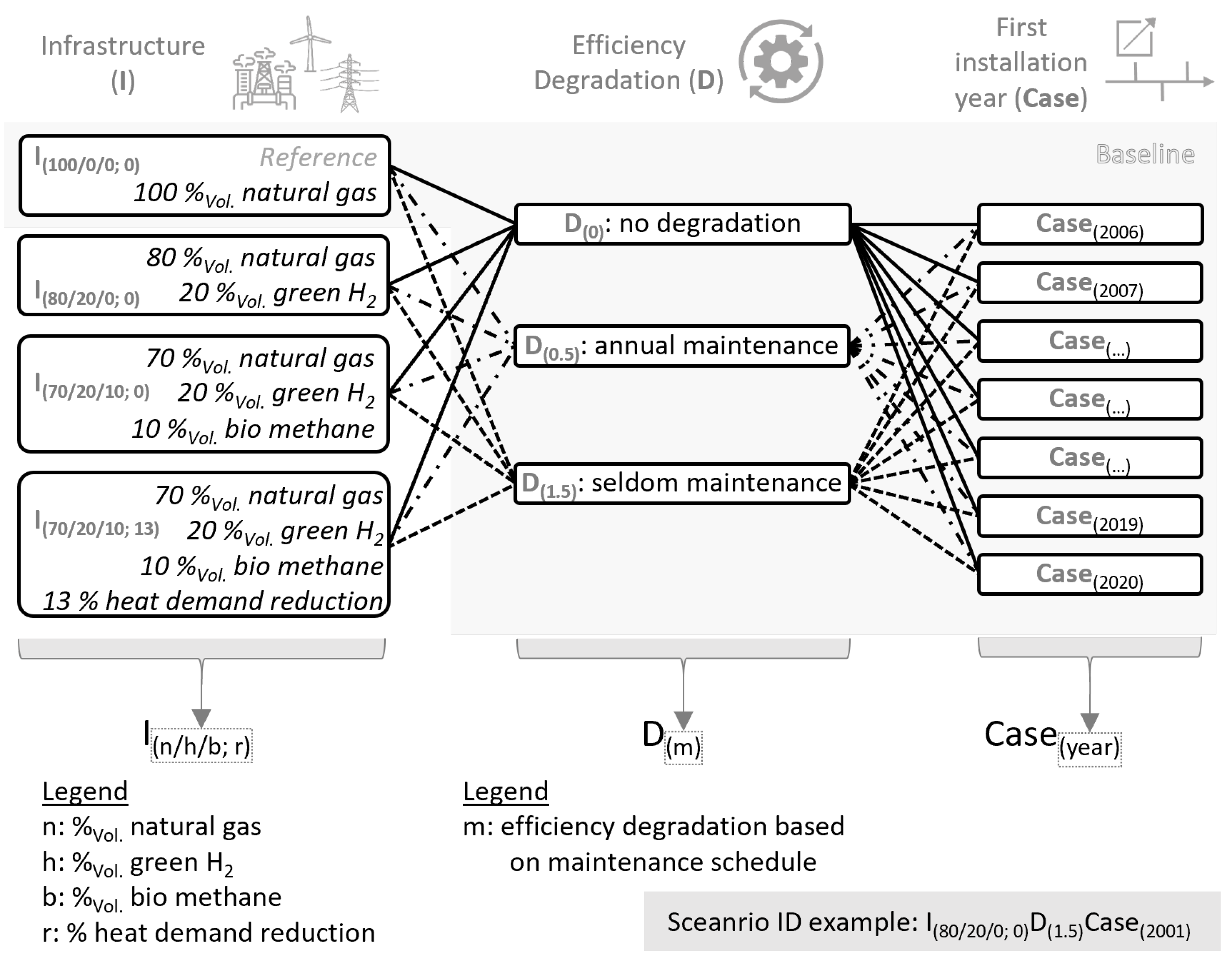
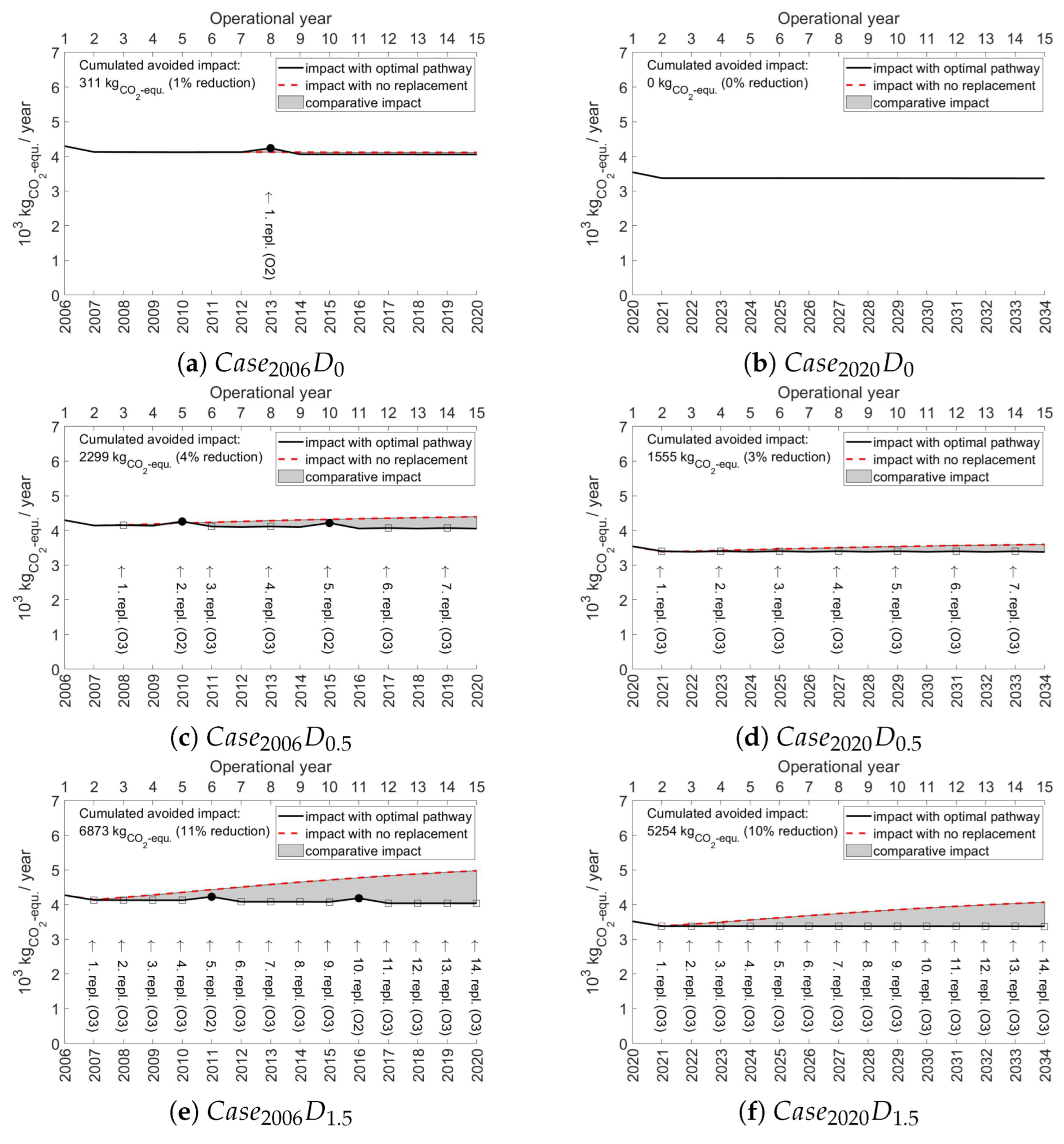
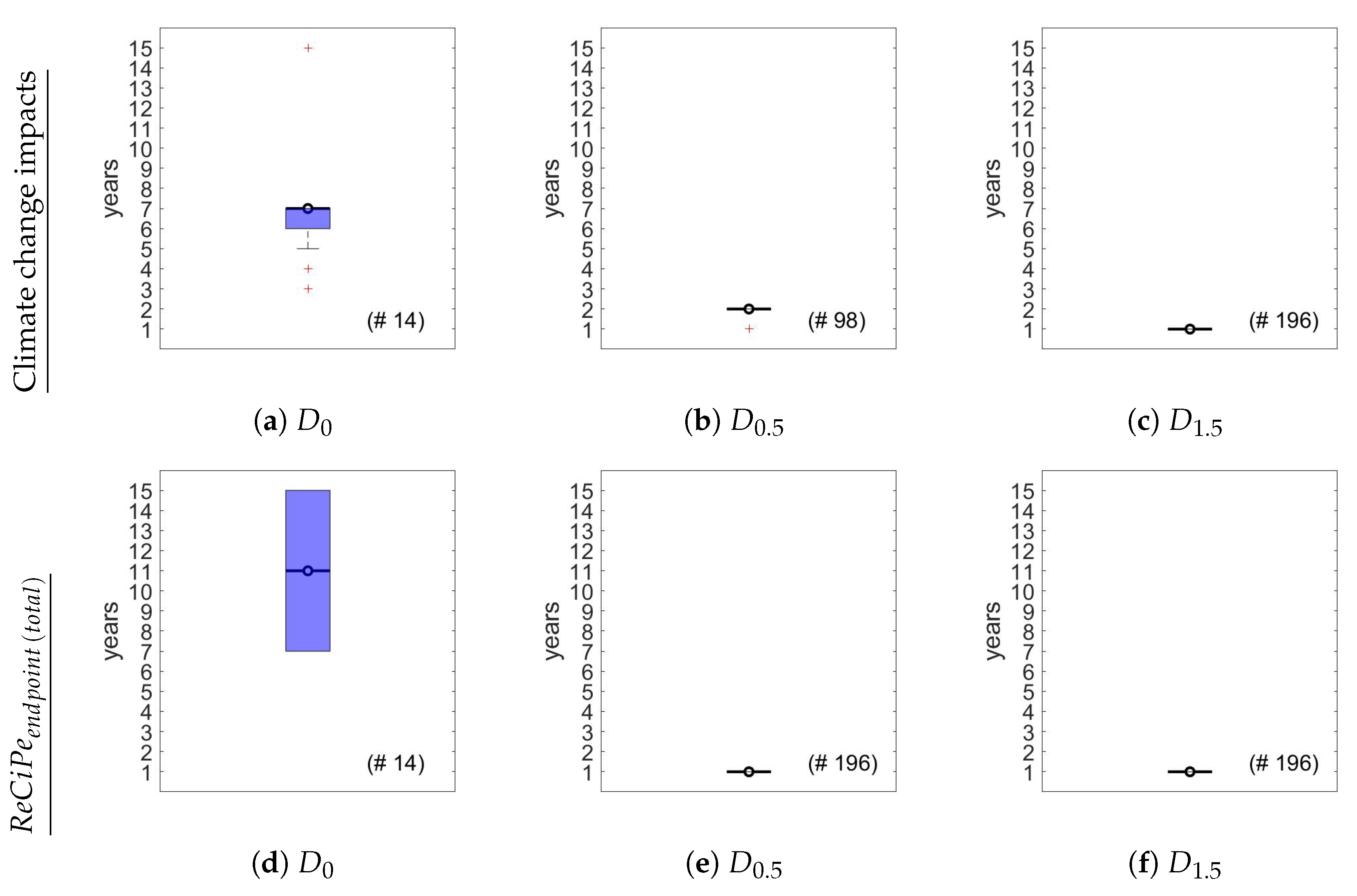
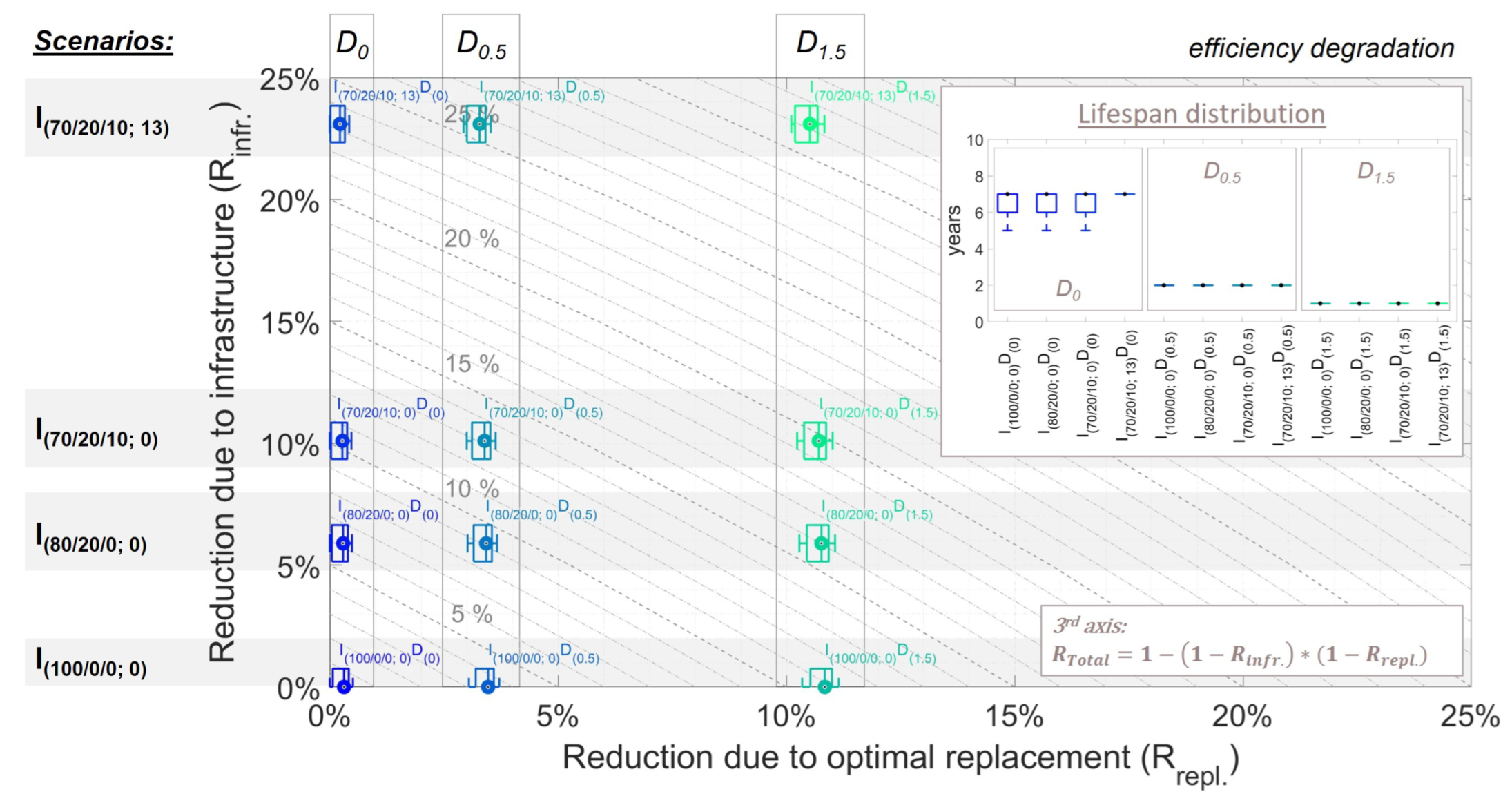
| Optimization Objective | Mathematical Approach | Reference Authors | Replacements Actions | Replacement Options at the Same Time | Non-Linear Optimization Problem ** | Application in Case Studies |
|---|---|---|---|---|---|---|
| Minimizing impact rate at break-even | Iterative approach with scenario assessment | van Nes and Cramer [14] | one | one | no | - |
| Analytical approach by solving integral | Dewulf and Duflou [18] | one | one | no | Cars, refrigerators | |
| Minimizing cumulative impact over a time horizon | Numerical approach in which derivatives of mathematical series are solved iteratively | Skelton and Allwood [30] | Several with (ir)regular frequency | one | no | Cars, plane, washing machine, office block |
| Dynamic programming | Kim et al. [31] *, Liu et al. [35], Chung et al. [37] | Several with irregular frequency | one | yes | Cars, refrigerators, freezers, washing machines, air conditioners, residential lightning | |
| Scenario assessment (no optimization algorithm) | Ardente and Mathieux [22], Boldoczki et al. [24], Pérez-Belis et al. [36] | one | one | no | Vacuum cleaners, washing machines, refrigerators, freezers, printers, laptops, monitors, PCs |
Disclaimer/Publisher’s Note: The statements, opinions and data contained in all publications are solely those of the individual author(s) and contributor(s) and not of MDPI and/or the editor(s). MDPI and/or the editor(s) disclaim responsibility for any injury to people or property resulting from any ideas, methods, instructions or products referred to in the content. |
© 2023 by the authors. Licensee MDPI, Basel, Switzerland. This article is an open access article distributed under the terms and conditions of the Creative Commons Attribution (CC BY) license (https://creativecommons.org/licenses/by/4.0/).
Share and Cite
Hummen, T.; Hellweg, S.; Roshandel, R. Optimizing Lifespan of Circular Products: A Generic Dynamic Programming Approach for Energy-Using Products. Energies 2023, 16, 6711. https://doi.org/10.3390/en16186711
Hummen T, Hellweg S, Roshandel R. Optimizing Lifespan of Circular Products: A Generic Dynamic Programming Approach for Energy-Using Products. Energies. 2023; 16(18):6711. https://doi.org/10.3390/en16186711
Chicago/Turabian StyleHummen, Torsten, Stefanie Hellweg, and Ramin Roshandel. 2023. "Optimizing Lifespan of Circular Products: A Generic Dynamic Programming Approach for Energy-Using Products" Energies 16, no. 18: 6711. https://doi.org/10.3390/en16186711






